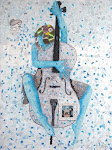
BERLIN (AFP) — 20 ans après l'ouverture du Mur de Berlin, les premiers artistes invités à restaurer la fresque qui orne une longue section de la construction ont commencé mardi à repeindre leurs oeuvres.
"Les quatre premiers artistes sont arrivés hier (lundi)", a indiqué à l'AFP Kani Alavi, directeur de l'association des artistes de l'East Side Gallery.
"Ils vont peindre les mêmes motifs qu'en 1990 et c'est pour nous une très grande victoire", s'est réjoui M. Alavi. "Sinon, nous n'aurions peut-être pas eu la chance de conserver cette authenticité."
Décorée en 1990 par 118 artistes issus d'une vingtaine de pays, cette fresque appelée "East Side Gallery" s'étale sur 1,3 km le long de la rivière Spree.
Cette succession de peintures est présentée comme la plus grande galerie de plein air au monde. Elle est située sur la face Est du "Mur de protection antifasciste", vierge de toute inscription avant l'ouverture des frontières entre la RFA et la RDA.
Selon M. Alavi, 86 peintres ont déjà répondu positivement à l'invitation de l'association. Chaque artiste pourra rester entre deux semaines et un mois sur place pour repeindre son oeuvre. Les nouvelles peintures doivent être terminées pour le 7 novembre, soit deux jours avant le 20e anniversaire de la chute du Mur.
"Je suis excitée et me réjouis surtout que ce mur puisse être restauré en tant que monument", a expliqué Rose-Marie Schinzler, auteur de deux peintures et qui habitait Berlin-Ouest en 1990.
"Le dernier état du lieu était catastrophique", témoigne de son côté Gerhard Lahr, artiste originaire de Berlin-Est. "Il fallait faire quelque chose car ce mur s'est transformé en une véritable attraction pour les touristes."
D'autres refusent toujours de venir à Berlin restaurer leurs oeuvres s'ils ne reçoivent pas 15.000 euros d'honoraires au lieu des 3.000 prévus. "Nous voulons tout simplement une transparence complète de l'argent accordé aux artistes", a revendiqué à l'AFP Bodo Sperling, responsable du collectif qui a lancé la fronde et qui réunit, selon lui, une dizaine d'artistes.
http://www.google.com/hostednews/afp/article/ALeqM5h-SA53NYK7l2d1K_hIf_rC6B43lw
BERLIN (AFP) — Restoration work began Tuesday on murals painted on the longest remaining stretch of the Berlin Wall, 20 years after the Cold War barrier fell, organisers said.
Completed in 1990, the 1.3-kilometre-long (0.8-mile-long) East Side Gallery is covered with paintings by 118 artists from around the world, inspired by the tumultuous emotions that marked the end of Germany's division.
But the concrete slabs running along the Spree River, which are a tourist magnet, have crumbled under the onslaught of weather, pollution, graffiti artists and plain neglect.
One of the most famous works captures Soviet leader Leonid Brezhnev and the long-time leader of East Germany's communist regime Eric Honecker sharing a passionate kiss.
Kani Alavi, the head of the artists' association at the East Side Gallery, which calls itself the world's largest open-air art gallery, said four of the original artists had set to work and another 82 had pledged to participate.
"They will paint the same motifs as they did in 1990 and that is a major victory for us," he said. "If they did not, we would probably not have the chance to preserve its authenticity."
The retouching work is to be wrapped up in November, in time for the anniversary celebrations of communist East Germany's decision to open the border on November 9, 1989 amid a peaceful popular uprising.
"I am excited and am particularly happy that the Wall will be restored like a historical monument," said Rose-Marie Schinzler, who painted two of the works.
But some artists have refused to join in the effort and are demanding 15,000 euros (19,900 dollars) in compensation instead of the 3,000 euros on offer, arguing that they have not received a fair share of the Gallery's earnings over the years.
"We simply want total financial transparency for the artists," Bodo Sperling, who said he leads a group of about a dozen artists boycotting the restoration, told AFP.
The despised Wall was erected in 1961 by the communist regime of East Germany to stop a mass exodus of its citizens.
Of the 155 kilometres of grey concrete that cut off West Berlin from its hinterland for 28 years and made East Germans prisoners of their own country, only about three kilometres in total is still standing.
It was chiseled apart by Germans from East and West euphoric over the opening of the border in 1989 and large slabs were sold off to foreign buyers.
Two decades on, visitors to the city centre often search in vain for the Wall and can rarely differentiate between the former East and West, both of which have seen a dramatic construction boom since the barrier was torn down.








Sem comentários:
Enviar um comentário